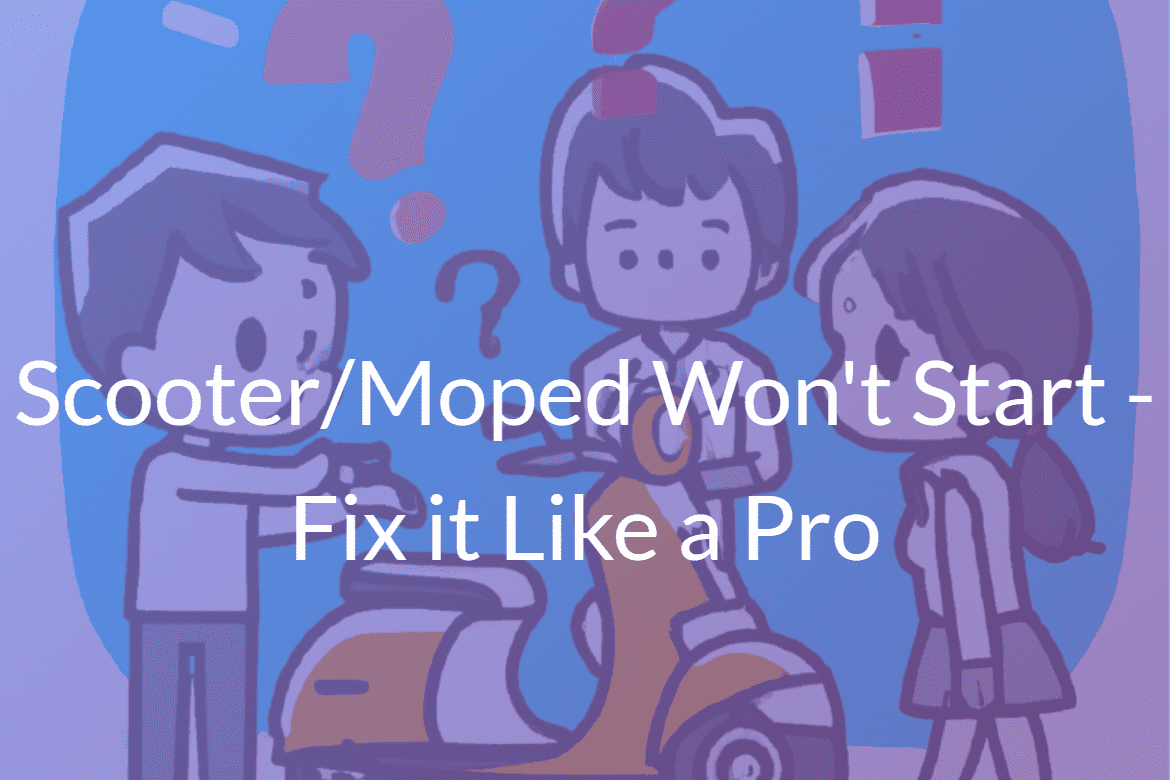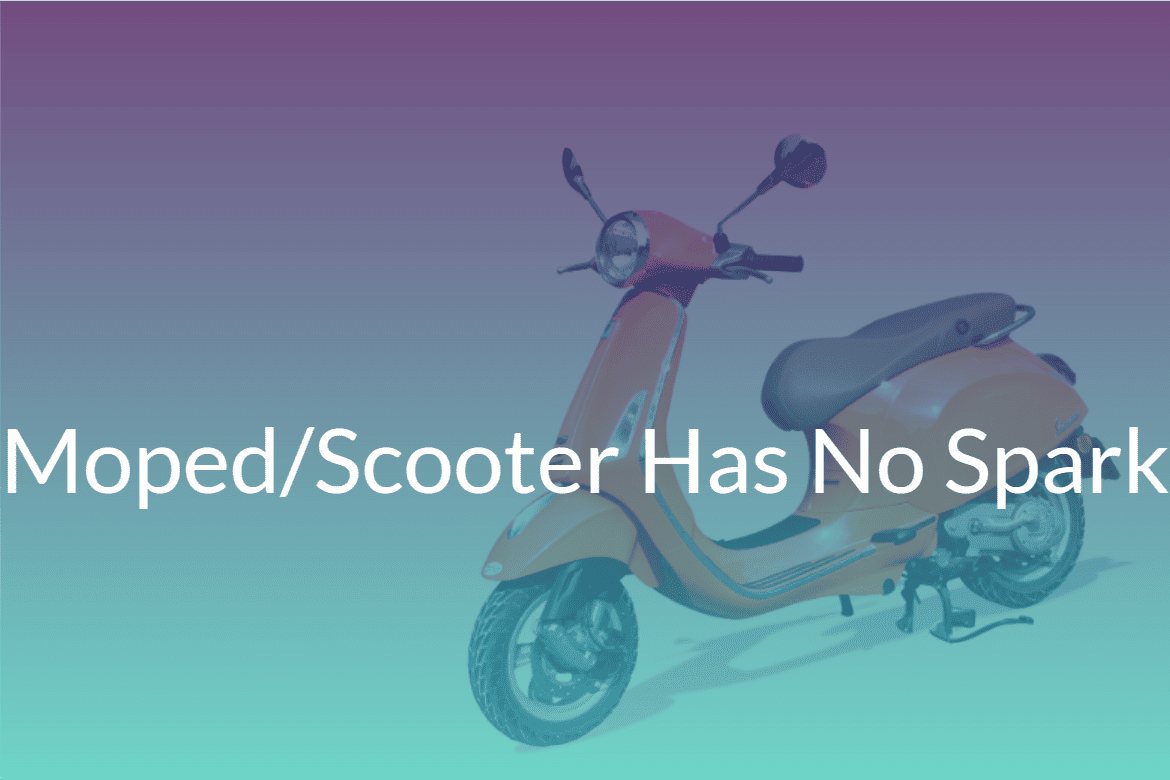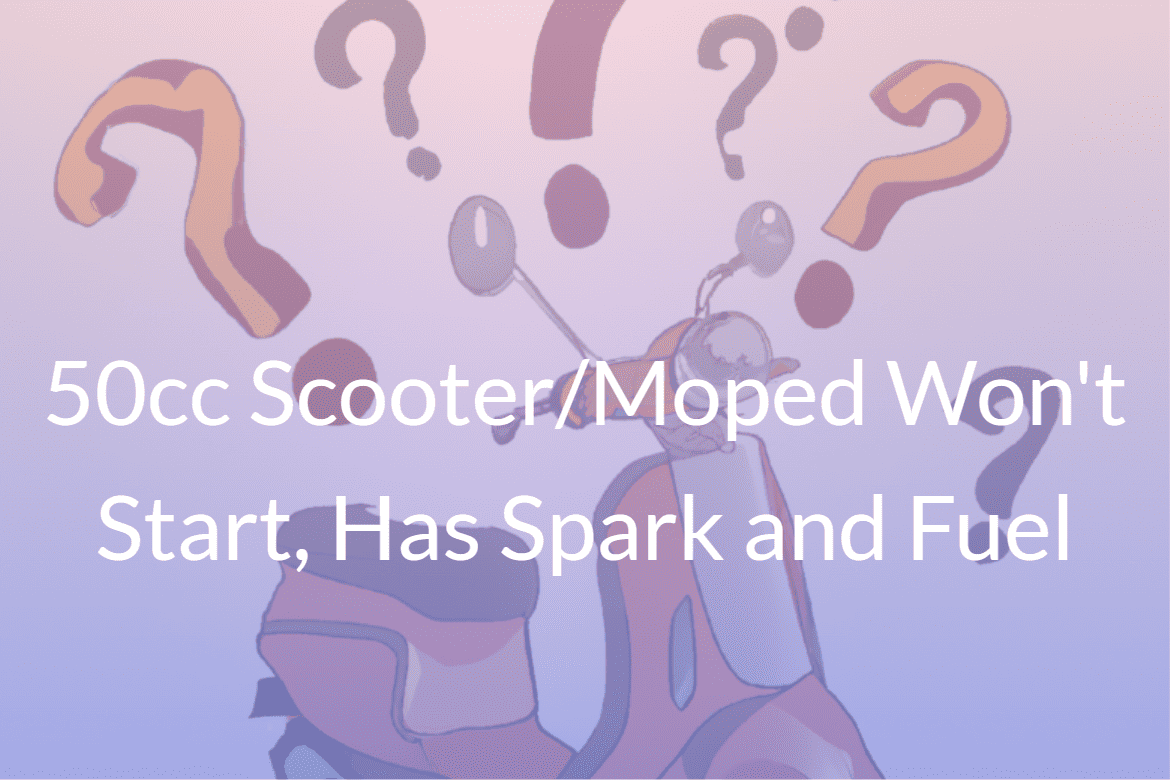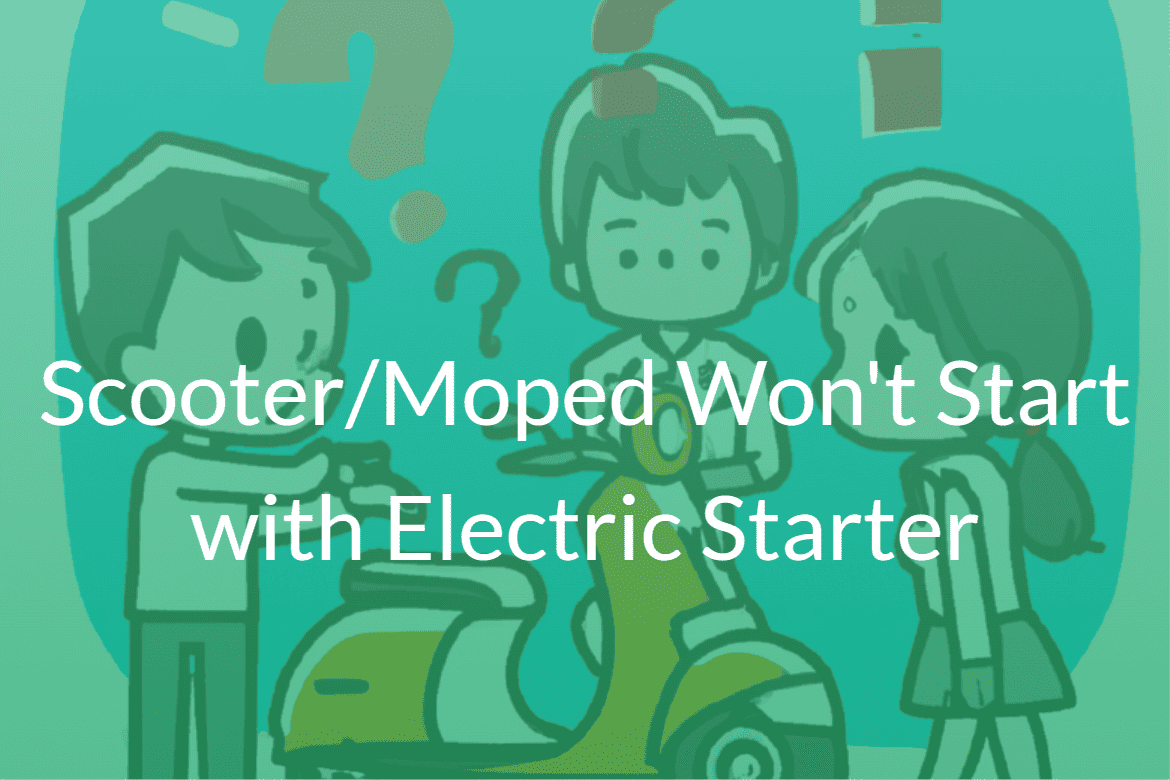If you’re reading this, we’re guessing your scooter or moped is refusing to start, and you’re looking for a solution. Don’t stress, this article will explain the most common reasons your scooter might be giving you trouble in a way that’s easy to understand. And, these methods will work for 50cc, 125cc, 150cc, or really any size of a moped or scooter.
Once you’ve got the hang of it, you’ll be able to tackle the issue and get back on the road in no time. To keep things straightforward, we’ll be focusing on the four primary systems that can cause starting problems: fuel, air, ignition, and compression. Each of these systems plays a crucial role in making your scooter or moped run smoothly.
We’ll go through them one by one, discussing the common issues you might encounter and offering practical solutions to get your moped back in action.
Scooter/Moped Won’t Start: The Basics
To get started, let’s break down the four fundamental elements that a scooter or moped needs to run. These are fuel, air, compression and ignition.
Fuel
Fuel is, of course, essential for your scooter or moped to run. The engine requires a specific mixture of fuel (usually gasoline) and air to operate efficiently. If there’s a problem with the fuel supply, the engine won’t start. Common issues include a clogged fuel filter, a blocked fuel line, a carburetor that is blocked, or an empty gas tank.
Air
Air is needed to mix with the fuel for combustion. Your scooter or moped has an air filter that ensures clean air is entering the engine. If the air filter is dirty or clogged, it will restrict the airflow and could prevent the engine from starting. The fuel/air ratio is controlled by the carburetor, and again, problems within the carburetor can prevent your moped from starting.
Compression
Compression is the process where the engine squeezes the fuel and air mixture in the cylinder, making it more concentrated and ready for ignition. This is achieved by the piston moving up and down within the cylinder. If the compression is too low or there’s a leak, the engine will not start. To check for proper compression, you can use a compression tester, which is a simple tool that you screw into the spark plug hole. If the compression is low, you might need to replace worn-out piston rings, gaskets, or valves.
Ignition
Ignition refers to the spark that ignites the compressed fuel and air mixture, creating a small explosion that powers the engine. In scooters and mopeds, this spark is generated by the spark plug, which is connected to the ignition coil. If there’s no spark or a weak one, the engine won’t start. To troubleshoot ignition issues, a multimeter is often required. A spark tester is also a handy, inexpensive item that will help you get to the bottom of the problem.
Scooter/Moped Won’t Start – Fuel Problems
Carbureted Engines
In this section, we’ll cover fuel-related issues for carbureted engines that might prevent your scooter or moped from starting. We’ll explain the common causes of fuel problems and provide easy-to-understand, step-by-step instructions to help you fix these issues.
Empty or Contaminated Gas Tank
Sometimes, the most straightforward issue can be the cause and you’d be surprised how common this is. To check and resolve this problem:
- Inspect the fuel level in your gas tank (never rely on a guage, visually check in the tank)
- If it’s empty, refill it with the correct type of gasoline.
- If the gas is old, smells stale or you believe it could be contaminated with water or debris, drain the tank and refill it with fresh fuel.
A gasoline siphon pump can help you safely remove old or contaminated gas from the tank.
Clogged Fuel Filter
A fuel filter prevents dirt and debris from entering the engine. If it’s clogged, the engine won’t get enough fuel to start. To check and replace a clogged fuel filter:
- Locate the fuel filter, usually found along the fuel line between the tank and the carburetor. It is also common for a filter to be housed inside the fuel tank above the fuel tap.
- Remove the fuel filter and check for dirt or debris. (if you are checking the fuel filter within the tank, you will need to siphon the fuel out first)
- If it’s clogged, clean it if possible or replace it with a new one.
- Reconnect the fuel lines, making sure they’re secure and free of leaks.
Blocked Fuel Line
A blocked fuel line can also prevent the engine from getting the fuel it needs to start. To inspect and clear a blocked fuel line:
- Trace the fuel line from the gas tank to the carburetor (and manifold if a vacuum petcock (fuel tap) is used).
- Look for any kinks, pinches, or damage that could restrict fuel flow.
- If necessary, replace the fuel line with a new one (making sure to measure the inside and outside diameter to make sure you get the right fit)
- Reconnect the fuel line, ensuring a proper fit and no leaks.

Mopeds normally use a vacuum style petcock (fuel tap), which means they have 2 fuel lines. One pipe uses a vacuum (suction) from the engine to open the fuel tap and allow fuel to flow down the other.
Locate both fuel lines coming from the petcock on the bottom of the tank, the one that goes into the carburetor will carry fuel, the other will operate the vacuum.
Take both fuel lines off at their furthest point from the tap (the attachments at the carburetor and the inlet manifold).
Put the fuel line that was attached to the carburetor into a suitable container to catch any fuel and use a large syringe to suck on the other fuel line.
If you see a steady flow of fuel coming from the line that was attached to the carburetor, you have now eliminated a broken fuel tap, clogged fuel filters, restricted fuel lines or any other fuel problem before the carburetor.
Malfunctioning Carburetor/Blocked Jets
The carburetor is responsible for mixing fuel and air in the right ratio for combustion. It uses things called jets (small nozzles) to pass the correct quantity of fuel through. A malfunctioning carburetor or blocked jets is a common fault that can prevent the engine from starting. To diagnose and fix carburetor issues:
- Locate the carburetor, which is usually connected to the air filter and engine.
- Inspect the carburetor for signs of damage, debris, or fuel leaks.
- Remove the carburetor, this will involve removing fuel lines, oil feed line (2-strokes), throttle assembly and air filter pipework.
- Clean the exterior of the carburetor using a carburetor cleaner and a soft brush or cloth.
- Disassemble the carburetor and thoroughly clean all internal components and jets, you’ll need this jet cleaning kit, compressed air or an ultrasonic cleaner to do this properly (use the video below to guide you through this process).
- Reassemble and reinstall the carburetor, making sure all connections are secure and properly adjusted.
Faulty Reed Valves (2-Stroke Engines Only)
Reed valves play a crucial role in 2-stroke engines by controlling the flow of the fuel-air mixture from the carburetor to the combustion chamber. They work as one-way valves, allowing the mixture to enter the chamber but preventing it from flowing back into the carburetor. If the reed valves are damaged, cracked, or not sealing properly, your scooter or moped may have trouble starting or running efficiently.
To inspect and replace faulty reed valves:
- Locate the reed valve assembly, typically found between the carburetor and the engine’s crankcase, normally under the inlet manifold.
- Remove the reed valve cover by unscrewing the bolts or fasteners holding it in place, i.e. remove the inlet manifold.
- Inspect the reed valves for damage, cracks, or poor sealing. Pay attention to the thin petals that should lay flat against the valve body.
- If the reed valves are damaged or not sealing properly, replace them with a new set, you will most likely need a precision screwdriver set for this.
- Reassemble the reed valve cover, ensuring a secure and airtight fit.
Fuel-injected Engines
In this section, we’ll discuss fuel injection problems that might prevent your scooter or moped from starting. We’ll explain the common causes of fuel injection issues and provide easy-to-understand, step-by-step instructions to fix these problems.
Faulty Fuel Pump
A fuel pump supplies fuel from the gas tank to the fuel injectors. If it’s not working correctly, the engine won’t get the fuel it needs to start. To diagnose and replace a faulty fuel pump:
- Turn on the ignition and listen for the fuel pump to prime, you should hear a faint humming noise (the fuel pump is usually located within the fuel tank with access from above).
- If you don’t hear the pump, check the fuel pump fuse, relay, and wiring for issues.
- If these components are in good condition, use a multimeter to check for voltage to the fuel pump.
- If there is voltage to the pump but it still isn’t working, replace the fuel pump, if no voltage, continue searching for wiring issues.
- Install the new fuel pump and reconnect all connections, making sure they’re secure and free of leaks.
A multimeter will be helpful for checking the fuel pump’s electrical connections.
Damaged or Leaking Fuel Lines
Damaged or leaky fuel lines can prevent fuel from reaching the injectors. To inspect and replace fuel lines:
- Trace the fuel lines from the gas tank to the fuel injectors.
- Look for any signs of damage, leaks, or kinks that could restrict fuel flow.
- If necessary, replace the damaged fuel lines with new ones.
- Reconnect the fuel lines, ensuring a proper fit and no leaks.
Clogged Fuel Injectors
Fuel injectors deliver the right amount of fuel into the engine. If they’re clogged, the engine won’t get enough fuel to start. To clean and unclog fuel injectors:
- Locate the fuel injector, usually found on the intake manifold or on/around the cylinder head.
- Remove the fuel injector from the engine.
- Use a carb cleaner to clean the exterior of the fuel injector.
- While it is possible to clean the internals of fuel injectors using carb cleaner, compressed air and some electrical know how, it isn’t the safest thing to do and obviously not something we’d recommend novices to attempt. It’s probably best to take the injector to a shop and have it cleaned professionally, this won’t cost you much.
- Reinstall the fuel injector, making sure all connections are secure and free of leaks.
Faulty Engine Control Module (ECM)
The Engine Control Module (ECM) manages the fuel injection system. A malfunctioning ECM can cause starting problems.
Running diagnostics on a moped often requires expensive, specialist tools and equipment that only dealers and other professionals will have. So, if you have tried everything else in this article and it still won’t start, you might need to take your moped in for professional help at this point.
There are adapters on the market that claim to connect general OBD-II code readers to your mopeds diagnostic system. Trust us, these are very hit and miss, and even if they work at all, you still won’t have access to what you need to!
Scooter/Moped Won’t Start – Air Problems
In this section, we’ll go through the air-related issues that might prevent your scooter or moped from starting. We’ll explain the common causes of air problems and provide easy-to-understand, step-by-step instructions to fix these issues.
Dirty or Clogged Air Filter
A dirty or clogged air filter restricts airflow to the engine, making it difficult to start. To check and clean or replace the air filter:
- Locate the air filter, typically found inside the airbox near the carburetor or throttle body.
- Remove the air filter and inspect it for dirt or debris.
- If it’s dirty, clean it using a mild soap and water solution or an air filter cleaner, then let it dry completely.
- If it’s damaged or excessively dirty, replace it with a new one.
- Reinstall the air filter, ensuring proper fit and secure connections.
Cracked or Leaking Intake Manifold
The intake manifold directs the air and fuel mixture into the engine. If it’s cracked or leaking, the engine won’t get the right air-fuel mixture, making it hard to start. To inspect and fix the intake manifold:
- Locate the intake manifold, which connects the carburetor or throttle body to the engine.
- Inspect the manifold for cracks, damage, or leaks.
- If necessary, replace the damaged intake manifold with a new one.
- Reconnect the intake manifold, ensuring a proper fit and no leaks.
Vacuum Leaks
Vacuum leaks occur when air enters the engine through unplanned pathways. This can disrupt the air-fuel mixture and cause starting issues. To find and fix vacuum leaks:
- Inspect all vacuum lines and connections around the intake manifold, carburetor, or throttle body for signs of damage or loose connections.
- Replace any damaged vacuum lines or hoses with new ones.
- Tighten any loose connections or fittings.

This may be helpful for locating vacuum leaks and cracked manifolds if your engine RUNS, but it’s something worth knowing!
Start your scooter or moped and let it idle.
Grab a can of WD-40 and attach the straw nozzle to the spray head for more precise application.
Carefully spray a small amount of WD-40 around the intake manifold, vacuum lines, and any other potential leak points.
Pay close attention to the engine’s idle speed while spraying. If the idle speed suddenly increases or becomes smoother when you spray the WD-40 in a specific area, it’s likely that you’ve found a vacuum leak.
Remember to exercise caution when spraying WD-40 around a running engine, as it is flammable. Keep it away from the exhaust and other hot components and avoid spraying excessive amounts.
Malfunctioning Idle Air Control (IAC) Valve (fuel-injected engines)
The IAC valve regulates the engine’s idle speed by controlling the amount of air that bypasses the throttle. If it’s not working correctly, the engine might not start or maintain idle. To diagnose and fix a malfunctioning IAC valve:
- Locate the IAC valve, usually found near the throttle body.
- Inspect the valve for damage or debris, and clean it using throttle body cleaner and a soft brush or cloth.
- If the problem persists, replace the IAC valve with a new one.
- Reinstall the IAC valve, ensuring proper fit and secure connections.
Scooter/Moped Won’t Start – Ignition Problems
In this section, we’ll talk about ignition-related issues that will prevent your scooter or moped from starting. We’ll explain the common causes of ignition problems and provide easy-to-understand, step-by-step instructions to fix these issues. If you’ve found that your problem isn’t fuel or air related, ignition problems what we see the most frequently.
Dead or Weak Battery
A dead or weak battery might not provide enough power to crank the engine and start your scooter or moped. To check and charge or replace the battery:
- Locate the battery, often found under the seat or inside a battery compartment.
- Use a multimeter to check the battery voltage; it should read around 12.6 volts for a fully charged battery.
- If the battery is weak, charge it with a battery charger
- If the battery doesn’t charge or the scooter still struggles to crank, then test the battery with a battery tester.
- Consider replacing the battery with a new one.
Faulty Ignition Coil
The ignition coil is responsible for generating the high voltage required to create a spark at the spark plug. If it’s not working properly, the engine won’t start. To diagnose and replace a faulty ignition coil:
- Locate the ignition coil, usually found near the spark plug or mounted on the frame.
- Use a multimeter to check the resistance of the ignition coil; if it’s outside the manufacturer’s specifications, replace it with a new one. (use the video below to help you do this)
- Reconnect the ignition coil, ensuring secure connections.
Damaged or Fouled Spark Plug
A damaged or fouled spark plug can’t create the spark needed for combustion, preventing the engine from starting. To check and clean or replace the spark plug:
- Locate the spark plug, typically found on the cylinder head or engine block.
- Remove the spark plug using a spark plug socket and ratchet.
- Inspect the spark plug for damage, fouling, or excessive wear. If it’s dirty clean up using a wire brush.
- Check the spark plug gap and adjust if necessary, using a spark plug gapping tool.
- Replace the spark plug with a new one if required.
- Reinstall the spark plug, ensuring proper torque and secure connections.
Broken Ignition Switch
A malfunctioning ignition switch can prevent the engine from starting, when you turn the key to the on position, the spark plug should be able to generate a spark, when you turn the key off, the spark will stop, stopping the engine. To diagnose and fix a malfunctioning ignition switch:
- Check the key for damage or excessive wear; if necessary, replace it with a new one.
- Inspect the ignition switch for damage or loose connections.
- Use a multimeter to test the continuity of wires or terminals on the ignition switch to ensure it is working correctly. (Use the video below to help you)
- If the ignition switch is damaged, replace it with a new one.
- Reconnect the ignition switch, ensuring secure connections.
Damaged or Disconnected Spark Plug Wire
A damaged or disconnected spark plug wire can prevent the spark from reaching the spark plug, causing the engine not to start. To check and fix the spark plug wire:
- Locate the spark plug wire (HT lead), which runs from the ignition coil to the spark plug.
- Inspect the wire for damage, cracks, or loose connections.
- If necessary, replace the damaged spark plug wire with a new one.
- Reconnect the spark plug wire, ensuring a secure connection to both the ignition coil and the spark plug.
Faulty Pickup Coil or Trigger (CDI ignition systems)
The pickup coil, also known as the trigger, sends a signal to the CDI (Capacitor Discharge Ignition) unit to fire the ignition coil at the right time. If it’s malfunctioning, the engine won’t start. To diagnose and replace a faulty pickup coil:
- Locate the pickup coil, typically found near the flywheel or stator assembly.
- Use a multimeter to check the resistance of the pickup coil; if it’s outside the manufacturer’s specifications, replace it with a new one. (watch the video below to help you)
- Reconnect the pickup coil, ensuring secure connections.

Using a spark tester will immediately prove the entire ignition system, including the ignition switch, up to the spark plug.
This little device is cheap and easy to use, just plug one end into your spark plug cap, the other onto your spark plug.
Watch for a spark inside the clear unit when you turn the engine over (crank it).
Simple!
Scooter/Moped Won’t Start – Compression Problems
In this section, we’ll talk about compression problems that might stop your scooter or moped from starting. Compression problems are the least frequent of the problems we see on mopeds and scooters, but they definitely still happen. We’ll explain the usual reasons for low compression and give you step-by-step instructions to fix these issues.
Taking apart and rebuilding an engines piston and cylinder can be a little tricky, especially on a 4-stroke. The below video should guide you through the process, but when dealing with compression related engine problems, if your mechanical skills are a little rusty, it might be worth taking the bike to a professional.
Worn or Damaged Piston Rings
Piston rings are like metal bands that seal the space between the piston and the cylinder wall. They can wear out, break, or lose their tightness, causing low compression. To check and change piston rings:
- Take off the cylinder head and cylinder.
- Remove the piston from the connecting rod gently.
- Check the piston rings for signs of wear, damage, or broken parts.
- If needed, replace the piston rings with new ones.
- Put the engine back together, making sure to follow the correct specifications and place gaskets properly.
A piston ring compressor can be helpful for installing new piston rings.
Leaking Valves (4-stroke only)
The intake and exhaust valves can leak if they don’t close correctly or are damaged, leading to a loss of compression. A valve is supposed to stop and start the flow of gasses within the engine, so leaking valves mean the engine is not operating as it should. To find and fix leaky valves:
- Take off the cylinder head.
- Look at the valves and valve seats for damage or wear.
- If necessary, do a valve job, which means grinding the valves and seats to make a good seal.
- Change any damaged valves or valve parts
- Put the cylinder head and engine back together, following the right specifications and placing gaskets correctly.
If you need to remove valves from the cylinder head, you will need a valve spring compressor kit. When refitting or fitting new valves, a valve lapping tool and valve grinding compound will help you grind the valves and seats to ensure a good seal.
Damaged or Blown Head Gasket
A head gasket seals the space between the cylinder head and the engine block. If it’s damaged, broken, or not installed right, it can cause low compression. To change a bad head gasket:
- Remove the cylinder head.
- Check the head gasket for damage, like cracks or burned spots.
- Clean the cylinder head and engine block surfaces very well.
- Put in a new head gasket, making sure it’s aligned and facing the right way.
- Reassemble the cylinder head and engine, using the manufacturer’s torque specifications.
Cracked or Warped Cylinder Head or Engine Block
A crack or bent part in the cylinder head or engine block can cause low compression. These problems can be tricky to find and might need professional help. To look for a cracked or warped piece:
- Take apart the engine to see the cylinder head and engine block.
- Look closely at both parts for cracks or signs of bending.
- If there’s a crack, talk to a professional about fixing or replacing it.
- If you think it might be warped, a machine shop can check for flatness and fix it if necessary.
- Put the engine back together, following the right specifications and placing gaskets properly.
Cylinder/Piston Failure
Damage to the cylinder or piston can cause a loss of compression and prevent the engine from starting. This can result from normal wear and tear, overheating, or poor maintenance. To inspect and address cylinder/piston failure:
- Remove the cylinder head and cylinder.
- Carefully remove the piston from the connecting rod.
- Inspect the piston and cylinder for signs of damage, such as scoring, cracks, or excessive wear.
- If necessary, replace the piston, cylinder, or both.
- Reassemble the engine, ensuring proper torque specifications and gasket placement.
A cylinder honing tool can help you clean and smooth the cylinder walls if they show minor wear or scuffing.

Using a compression tester will immediately prove whether the engines got good compression or not.
They are cheap and very easy to use, anyone can use one!
Just remove the spark plug and screw the tester into the spark plug hole. Crank the engine and take the reading on the gauge.
Compare the reading to what the manufacturer says yours should be.
Voila, you’ve just figured out if your issue is compression related or not!
FAQ’s
Can I diagnose and fix scooter/moped issues myself, or should I take it to a professional?
Many of the problems mentioned in this blog post can be diagnosed and fixed by following the step-by-step instructions provided. However, if you’re not comfortable with the process or if the issue is complex (e.g., a faulty Engine Control Module), it’s best to consult a professional mechanic.
Can I use regular car engine oil for my scooter/moped, or do I need a specific type of oil?
Scooters and mopeds typically require a specific type of oil, which may be different from regular car engine oil. Check your owner’s manual for the recommended oil type and viscosity for your particular model. Using the correct oil will help ensure proper lubrication and performance.
How often should I change the oil in my scooter/moped?
The frequency of oil changes depends on your scooter/moped model and usage. Generally, it’s recommended to change the oil every 1,000 to 2,000 miles, or as advised in your owner’s manual. Regular oil changes help ensure proper engine lubrication and performance.
How do I properly store my scooter/moped for an extended period?
To store your scooter/moped for an extended period, follow these steps:
1. Fill the gas tank and add a fuel stabilizer to prevent fuel degradation.
2. Change the oil and clean the air filter.
3. Remove the battery and store it in a cool, dry place.
4. Inflate the tires to the recommended pressure and elevate the scooter/moped to prevent flat spots.
5. Cover the scooter/moped with a breathable cover to protect it from dust and moisture.
Can I jump-start my scooter/moped using a car battery?
While it’s technically possible to jump-start a scooter/moped using a car battery, it’s not recommended due to the risk of damaging your scooter’s electrical system. Instead, use a portable jump starter designed for motorcycles or scooters, or consider charging or replacing the scooter/moped battery if it’s dead or weak.
Conclusion
Understanding the four essential elements needed for your scooter or moped to run – fuel, air, compression, and ignition – is key to diagnosing and fixing problems that may prevent it from starting.
The aim of this article is to provide detailed, easy-to-understand explanations and solutions for common issues related to these elements.
By following the steps outlined and using the right tools, you can tackle most of the problems yourself and get your scooter or moped back on the road.
Regular maintenance and inspection of your scooter/moped can help prevent future issues and ensure a smooth, enjoyable ride, so it’s worth learning how a few things work.
Rhys is a qualified mechanic with a passion for mopeds and engines of all sizes. He has owned and worked on mopeds since his early teens and is dedicated to sharing his knowledge and helping others get the best of their machines. He currently owns 1 fully intact moped but has a few others in pieces in the workshop. More about Rhys
















